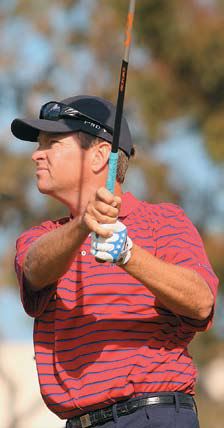 Teaching By Experience
Teaching By Experience
Raw talent: Jerry Lee Lewis, Tiger Woods, Lance Armstrong.
Talent makes a big, big difference.
Talent is nearly impossible “to teach”—we can only inform about talent and hope that our golf student catches on to what we are saying about a particular part of the game we are teaching.
Intuition about the game—how do we offer instruction to “Sally 22 Handicap” when she just wants to make contact and get it into the air (even just a little bit) and go have a scotch and water.
Here is the answer: You can only teach what you know by experience to be true. I would listen all day to Lee Trevino because of his wins and career experience; same goes for Bob Toski. Raw talent makes a big difference. Instead of teaching a golf student “15 things to remember on the back swing” maybe it is better for the PGA professional to say, “Just swing it away like a child in a playground swing.” Make it something they can relate to.
Chuck Yaeger knows everything about flying a plane due to his broad life experience doing just that. I am going to listen to him about flying, and maybe I, too, will understand his intuition about flying. So go find a golf instructor who has a bare-knuckle, school-ofhard- knocks experience, and take your note pad!
A Game in Transition, Part II
Wow, have we seen a lot of this lately in the good old U.S. of A. Golf is and has been fairly recessionproof just like these other “recession-proof businesses.” If you are in these businesses you are going to do fine over time: pet care of all kinds, veterinarians, selling cigarettes and alcohol, doing hair and nails and “the recreation of choice”—golf included, of course.
Golf is in a real state of flux right now and here is a look at our perfect storm which is going to affect golf for quite a while.
Golf has become too expensive for the average Joe. Joe just wants to play a round of golf and relax for a while. He does not really care about being greeted several times by several employees on his way to the first tee.
I am in favor of a good second greeting beyond the pro shop staff at registration, but honestly, how do we pay for all these other employees along the way? Ask Tamarack.
The Tamarack Resort, about an hour and a half from Boise, Idaho, went dark last fall. Over, out, done and mothballed until Cinderella comes along with $200 million-plus or an equity position beyond 50 percent.
Many resorts have a flawed business model. They think that folks from L.A. and the Bay area are going to come in for a few days and pay all the bills; all the while thumbing their nose at the Boise market, saying, “You people don’t count, you’re not sophisticated enough” to earn our business.” Sadly, a stay-and-play for $159 would have paid a lot of bills but that was not in the mix for this now ghost town of a resort.
Also affecting the landscape of the game is a waning loyalty to the golf professional. Members at the area country club will drive 15 miles one way to save $1 on a dozen balls and then brag it to the pro when they get to the club. (“Hey, dude! Forget about the 10 minute free lesson. Just go back to the discount store and see if they have a free lesson program.”)
Finally there is the issue of length and difficulty of the courses. It is way out of whack. A course should allow 15- to 20-handicappers (you know, the folks who really pay a large majority of all the bills) to play in 4 1/2 hours and not shoot 110 and lose six new Nike golf balls. Yeah, lot of fun here!
I can tell you what golf needs: It needs a return to the “Old Paths,” where the golf professional is the most important and respected person on the property (not the G.M. and not the superintendent).
Golfers want a face-toface dialog with the golf pro; maybe a story or a joke and maybe a comment about the new drivers—they could care less about the new tie the GM is wearing; they want to have some fun with the golf pro.
It’s the way golf was and the way golf should be again—an energized dialog with the golf pro and the customers who support the club; private or public.